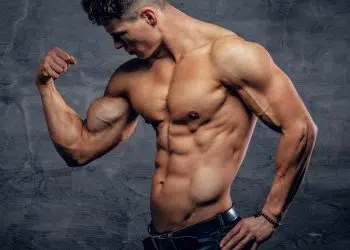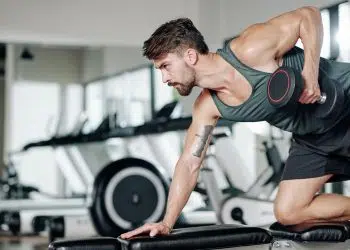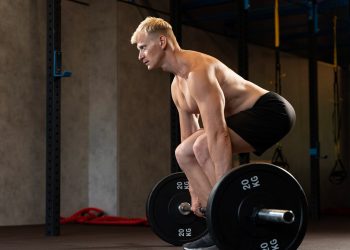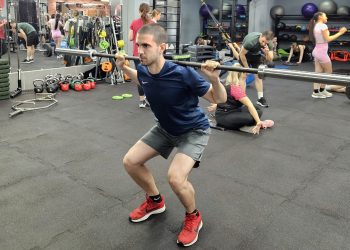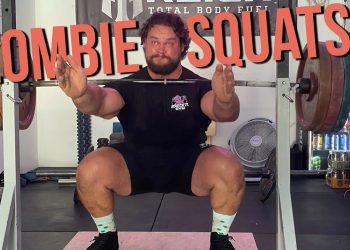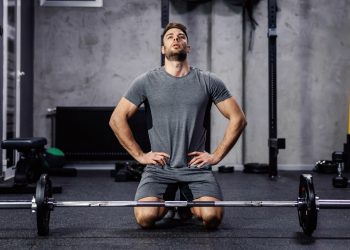The Smith chair squat is a great exercise for many reasons – it’s good for beginners, is a safe way to train the lower body, and teaches proper squat mechanics or technique (not entirely but we’ll get into that later on) to name a few of its benefits.
All you need is a Smith machine which is a common piece of training equipment found in most gyms around the world. It offers many advantages over freeweight exercise variations as you’re locked in place and able to focus just on the movement without needing to balance and stabilize any weight.
In this article, we’ve provided a full guide on this movement that includes details such as the muscles worked, how to do it, tips, benefits, variations, and more.
In This Exercise:
- Target Muscle Group: Quadriceps, gluteus maximus, and hamstrings;
- Type: Strength, hypertrophy, and function/athleticism
- Mechanics: Compound
- Equipment: Smith machine
- Difficulty: Intermediate
Summary
The Smith chair squat is a lower-body exercise variation that replicates what most of us do everyday - sit and stand up. Make no mistake though, it can be a great leg muscle and strength builder with the right training strategy. In this guide, we've discussed the muscles worked, how to do it, tips for best results, benefits, and how to include it in your training program.
Muscles Worked
The Smith chair squat, while a leg-focused exercise, actually involves your whole body. That’s what makes squats such an iconic and highly praised exercise because the benefits go beyond just building monster quads and a sexy bottom.
We’ve included details for each muscle group involved in this squat variation.
Gluteus Maximus
Gluteus maximus is the largest butt muscle that creates majority of the size, shape and appearance of the butt and hip muscles. The gluteus maximus is a very important muscle for function and aesthetics. The butt primarily extends and externally rotates the thighs and it plays an important role in helping us to maintain an upright posture.
Level Up Your Fitness: Join our 💪 strong community in Fitness Volt Newsletter. Get daily inspiration, expert-backed workouts, nutrition tips, the latest in strength sports, and the support you need to reach your goals. Subscribe for free!
Quadriceps
The quadriceps or quads for short is the large group of muscles that make up most of your upper leg mass. It has four heads; rectus femoris, vastus lateralis, vastus medialis, and vastus intermedialis.
These muscles help to flex the hips and extend the knees during movements such as squats. They’re also important for posture, walking, and the function of the spine and pelvis.
Any squat variation is going to really emphasize and activate the quadriceps muscles, and help improve aesthetics.
Hamstrings
The hamstrings is a three-headed muscle group consisting of semitendinosus, semimembranosus, and biceps femoris.
This muscle group is located on the back of the upper leg opposite the quads and functions to extend the hips and flex the knees. It’s important to note that the short head of the biceps femoris only crosses the knee joint and not the hip like the other two muscles.
The hamstrings play an important role in standing but also explosive activities such as sprinting and jumping.
Additionally, this three-headed muscle is active during the gait cycle to resist knee extension, plus it stabilizes the knee joints and has other functions too.
Squats work all of the upper leg muscles including the hamstrings and to a great degree.
Adductor Magnus
The adductor magnus is the largest of the muscles that make up the adductor group of muscles in the medial compartment of the thigh. While it assists during adduction of the thigh (limb moves toward center of the body), the adductor magnus also helps with hip extension and medial rotation. It has anterior and posterior fibers that help it act on the front and back of the leg.
Calf Muscles
The calves are the lower leg muscles consisting of the gastrocnemius and soleus. The gastrocnemius is the larger of the two and what most people think of when it comes to the calf muscles.
It’s the very visible muscle right below the knee that has two heads; medial and lateral and it gives the lower leg a lot of its shape. It joins with the soleus to form the Achilles tendon near the lower portion of the leg.
Then you have the soleus; a large muscle located deep to the gastrocnemius.
The calf muscles plantarflex (point the toes down) the foot and ankle. They are also important for posture, and athletic movements. Although they do have an uneven ratio of fast and slow-twitch fibers.
The gastrocnemius is composed of mostly fast-twitch fibers that make it better suited for quick and explosive movements. The soleus contains more slow-twitch fibers and is, therefore, better suited for endurance-type activities.
Tensor Fasciae Latae
The tensor fasciae latae or TFL for short works with the butt muscles to cause flexion, abduction and internal rotation of the hip. It can also affect the knee when combined with other muscles.
Core Muscles
Let’s be real a strong core is a non-negotiable requirement for a big squat. However, by progressing in your squat performance the trunk muscles will continue to develop and strengthen.
The main muscles that contribute to lifting performance are the deep abdominal stabilizers, multifidi (maintains a stable spine) and trunk extensors and muscles that line the spinal column.
How To Do The Smith Chair Squat
This squat variation involves a different set up and execution compared to a freeweight squat as the feet are positioned further in front of the body. You’re also able to focus a lot more than the actual movement.
But there’s a right and wrong way to set up and perform this exercise and being locked in can make things a little more challenging.
Here are step-by-step instructions for how to correctly perform this movement.
- Position the bar to the appropriate height so that you can comfortably get underneath and unrack it. For most people, this will be somewhere around the armpit/upper chest area. You don’t want the bar to be too low or too high.;
- Use the safety bars and set them to a good spot that will catch the bar when your upper legs bend below parallel.;
- Load up the desired weight.
- Get underneath the bar and adjust yourself to find a comfortable position. The bar should be set not too high or low on your traps (upper back) muscles.
- Place both feet about six inches in front of your body with a hip-width stance and toes straight forward. You may need to adjust as you’re doing the squats.
- Pretend there’s a chair under your butt and that the back of your knees are touching the edge of the chair as if you were going to sit down.;
- Keeping your core tense, squat down (sit in the chair) until your upper legs are parallel to the floor, feeling the weight and tension in your upper legs, glutes, and heels.;
- Push through the heels into a standing position and repeat for the desired number of repetitions.;
Here’s a video example of how to do this exercise.
Smith Chair Squat Tips
- One of the advantages of using a Smith machine is that it’s easier to adjust your foot and body position before you unrack the weight.;
- For this exercise, the knees should remain directly over the heels.;
- The feet can be narrower (but not too narrow) than usual for this variation.;
- Do not push your hips forward during the exercise. The squat down should feel natural and unrestricted.;
- Control the lowering portion of the movement to maximize muscle activation.;
Smith Chair Squat Benefits
The Smith chair squat is a machine-based multi-joint compound lower body exercise. It works the entire body and is a good option for lifters of all sorts. Want to build bigger and stronger legs? Are you a beginner? Or maybe you need an alternative to regular squats that require balance and stabilization… this exercise is a great choice and one we personally like.
Build Big and Strong Legs
Many will say the Smith machine is inferior to freeweight barbell squats and it may be in many ways and especially when it comes to the functional benefits. However, the fact that you do not have to balance and stabilize the weight means you’re free to focus on the lift portion.
This is going to allow you to lift heavy weight which can build big and strong legs.
Free Weight Barbell Squat Vs. Smith Machine Squat: Which Is Better For Gains?
No Balancing Required
One of the main advantages of doing machine squats is you’re locked into a position that does not require you to have to balance and stabilize the weight while you perform the exercise.
Level Up Your Fitness: Join our 💪 strong community in Fitness Volt Newsletter. Get daily inspiration, expert-backed workouts, nutrition tips, the latest in strength sports, and the support you need to reach your goals. Subscribe for free!
This is actually a popular and effective strategy for athletes or anyone looking to gain strength and mass while also preventing injuries.
Beginners and people recovering from injuries may find this exercise to be very beneficial.
A Great Squat Alternative
Freeweight squats are a must if you’re able to do them. However, that doesn’t mean you should do them and them only. Having some variety in your training offers benefits including preventing boredom but also allowing you to take advantage of various positions and, well, exercises.
Could Improve Deadlift Performance
We think the Smith chair squat could have some decent carryover to deadlifts and the variations of this total-body lift.
When it comes to deadlifting heavy weight, you have to lean back onto the heels to really maximize strength performance and this involves a lot of the posterior muscles such as the glutes and hamstrings.
With the Smith chair squat, the feet are further forward compared to a conventional freeweight squat, and this will recruit more of the posterior muscles.
Related: How To Increase Deadlift Performance
Teaches Good Squat form and Mechanics
A lot of beginner exercisers are not comfortable with balancing a barbell on their back. Using machines such as the Smith contraption is without a doubt ideal in this instance.
You can learn squat mechanics and then build up the confidence to use a freeweight barbell weight.
Drawbacks
Are there any drawbacks of the Smith chair squat?
You need a Smith machine
To do this exercise, you’ll need a Smith machine. If you train at home and don’t have access to one, this can be impossible to do.
Try this No-Squat Leg Workout for Lifters with No Squat Rack
Not the best for functional fitness
Because you don’t have to balance any weight, and the feet are positioned further forward than a conventional freeweight squat, it’s not as beneficial when it comes to transferring over to powerlifts and functional training. It will still engage the core muscles and build strength and mass in the legs, however.
Smith Chair Squat Variations
We also like these exercises that are similar to the Smith chair squat, and some even have advantages.
Use an actual chair or bench
A common technique for beginners who want to ensure they’re squatting low enough is to use an actual chair or bench. You can slide the bench under the Smith machine or if training at home, use a chair and descend until your butt touches it before standing up.
Pretty soon, you’ll have a good idea of how far down you need to go.
Smith machine squat
The conventional Smith machine squat is one of the best leg exercises for building mass and strength because you can load up the weight and replicate the freeweight barbell squat.
For this version, the body position and stance should more resemble a basic, conventional squat with the feet a little wider and pointed slightly outward.
Smith chair front squat
Front squats are as good as back squats for building mass and strength and may be better for the joints too (1). It’s a little more challenging to get used to but we recommend learning front squats for maximum development.
Try these 9 Best Front Squat Alternatives for Mass, Strength, and Athletic Performance
Suspension trainer/TRX chair squat
Using a suspension trainer such as the TRX or alternative suspension trainers is one way we would replicate the chair squat. That’s because you’re being supported and can therefore place your feet forward in front of your body which you cannot do with freeweight squats.
Using Smith Chair Squat Into Your Training Routine
As we explained before, the Smith chair squat is a good option to include in your workouts for many reasons. Here are some ways to take advantage of this total-body compound exercise.
Straight sets
One of the best ways to make progress and see gains is to do 2-4 challenging sets of an exercise. This keeps things simple and you know that this method works as it has forever and throughout history.
Here’s an example workout that you can do.
- Leg extension 2-3 sets
- Smith chair squat 2-4 sets
- Romanian deadlift 2-3 sets
- Leg curl 2-3 sets
Substitute for freeweight squats
On those days when you don’t want to balance a bar or dumbbells or want to switch things up a little, machine exercises can be just as effective for your physique and overall progress. Again, machine movements should not fully replace freeweight lifts but they do fit in perfectly into a complete workout program.
Learning the squat
We talked about this before but if you’ve not squatted with a freeweight barbell on your back, the Smith machine can make for a great introduction or transition because you can learn how to set up your stance and execute the movement using proper body position and form.
Read also: Smith Machine Squat Alternatives
Wrapping Up
If you were looking for another leg exercise to add in your training arsenal, this is one we’d definitely recommend. Or maybe you’re new to squats or aren’t ready to do freeweight barbell squats with a challenging weight.
The Smith chair squat is a good choice for many reasons and while it has disadvantages, the pros definitely outweigh the cons.
Interested in measuring your progress? Check out our strength standards for Smith Machine Squat, Deadlift, Hip Extension, and more.


